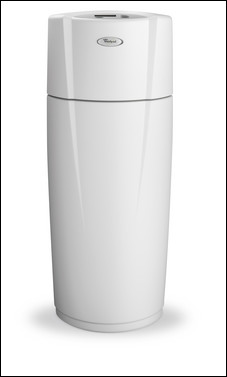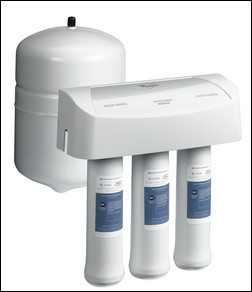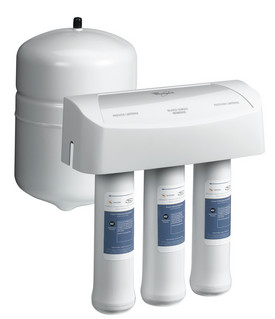Testing the Waters
Choosing the right filtration system begins with knowing one’s water. Households drawing water from a community water system should receive an annual drinking water quality report (sometimes called a Consumer Confidence Report), which informs the consumer of the water source, contaminant detection results and comparisons to drinking water standards. These reports are commonly mailed directly to the consumer, although they are also available by request from the water supplier.
 Whole-home Central Water Filtration System by Whirlpool |
Still, it is a good idea for all households—whether drawing from a community source or private well—to have the water tested. Older homes can contain lead pipes, and even newer homes may have pipes that were soldered with lead. Also, water suppliers may not be testing for certain contaminants or substances of which the household is concerned. “People can use their senses to decide if a test is necessary,” says Joe Harrison, technical director for the Water Quality Association (WQA), in Lisle, Ill. “You can tell by what you see, taste or smell.”
As a general rule, all homes should test for lead. Homes on well water should do a water test yearly as they are responsible for their own water quality. Well water testing should be done annually for nitrates and bacteria. The Environmental Protection Agency (EPA) has a set of water safety and quality guidelines for well owners. Currently the EPA regulates only 90 contaminants, and the standards set for these (called Maximum Contaminant Levels, or MCLs) only regulate the amount of a certain substance in the water. Homeowners who feel that a low level of a contaminant is still potentially harmful should seek a water filtration system that reduces or eliminates those contaminants.
The best way to have one’s water tested is to send a sample to an EPA-certified lab or to purchase a water testing kit. The list of EPA-certified labs by state can be found on their Web site, and a test with one of these labs usually costs between $10 to $30. The cost for a mail-in test kit is around $100 to $150. Testing costs increase with the number of contaminants being tested for, but the investment is worth it, especially for private well owners.
Choosing a System
Water system selection will depend on the water test results and the homeowner’s budget and specific needs. Just choosing among filter options alone can seem a daunting task, as the list includes—but is not limited to—carbon, ceramic, magnetic and alkalinizing filters and systems.
Carbon filters are the most common water filters. Depending on application, they can last six to nine months and will come in a several forms, including granular, solid carbon block and silver-impregnated charcoal. Silver-impregnated charcoal kills additional bacteria and filters chloramine. Carbon filters can be rated in microns—the lower the better—and lose efficiency with use. They can also be susceptible to mold development if not used regularly.
Magnetic water treatment systems pass the water over or through a magnetic field, rearranging the ions in the water. The effects of magnetic systems include smaller water molecules and softer water, although these systems alone do not filter the water of other contaminants.
Water ionizers split the incoming water into acidic and alkaline streams by using magnetically charged plates. The alkaline and acidic water is filtered first, and both streams boast alleged health benefits. The alkaline water in these systems is used for drinking, often resulting in “wasted” acidic water streams, which should be taken into account by the conservation-minded consumer. Water ionizers are most commonly sold for faucet-mounted or below-counter application. The health benefits of ionizing water are also a debated subject.
Filter systems will vary by application, as well. As mentioned, faucet-mounted, countertop and below-counter systems connect directly to the water supplying a faucet, most often in the kitchen. These are suitable for treating drinking water. Some of these models plug in and feature electrically powered controls and sensors. The cost for faucet-mounted or under-the-sink filtration systems can vary widely, with prices ranging from $30 to as much as $500.
The shower filter mounts to the showerhead and commonly filters chlorine from the water, resulting in a skin and hair-friendly showering experience. These devices are typically inexpensive, costing around $30.
Basic whole-home filters are great for homes with excessive rust or sediment issues. These units can vary widely depending on how many filtration and treatment functions they feature. Inexpensive units can cost as little as $50 while entire systems like the RainDance Water Systems WH-RO Series—which has a reverse-osmosis feature; pre-treats the water to remove iron, manganese, hydrogen sulfide gas, suspended solids and hard water; and neutralizes the pH of the water—will set a homeowner back by about $12,000.
Installation and Maintenance
Smaller filtration systems like shower filters, faucet-mounted or under-the-sink systems are relatively easy to install, even for the novice DIYer. Under-the-sink systems may require the drilling of mounting bracket holes and very basic knowledge of the sink’s water supply, but it is an installation project that shouldn’t take more than an hour. (For a step-by-step guide to installing an under-the-sink filtration system, view Renovate Your World’s video, “Install a Below-Counter Water Filtration System Video.”)
Installing a whole-home filtration system is a bigger project. Unsure homeowners should hire a qualified plumber for the job. DIYers should always follow the included instructions. “We recommend using a professional for whole-home installation jobs,” says Harrison. “Not only will they install it right; they can be called on for maintenance issues down the road.”
Routine maintenance of a below-counter or whole-home filtration system will almost always include swapping of used filters for new ones. Some filtration systems electronically monitor the state of the filter and will alert the owner when it is time to change filters. Others come with recommendations to change the filter after a certain number of months or gallons of usage. There are filtration systems that claim to have no maintenance needs, like Whirlpool’s Central Water Filtration System, a whole-home filtration unit that reduces chlorine odor and taste and filters sediment to protect plumbing and appliances. When selecting a filtration system, homeowners should look into replacement filter cost and recommended filter replacement frequency, as these will impact the lifetime costs of the system.
Reverse osmosis (RO) filters work by passing the water through a very fine membrane, creating highly filtered water very similar in nature to distilled water. There has been some debate regarding the distillation and/or reduction of natural minerals in water, with some findings linking health issues to l
 Whirlpool under-the-sink Reverse Osmosis Filter |
ong-term consumption of mineral-free water. However, reverse osmosis systems with activated carbon have been suggested for filtering out traces of pharmaceuticals, the latest contaminant to hit some of the country’s public water supplies. Whole-home RO filters are available, but they can be expensive; countertop or under-the-sink varieties are most common.
Ceramic filters are found in countertop and whole-home filter systems. They contain diatomaceous earth and nano-silver and will filter out bacteria and microorganisms.
Distillers boil the water and condense the steam to separate it from contaminants. These units tend to be expensive (as much as $1,500), run on electricity and can require professional installation.
Credit: Renovate Your World




























